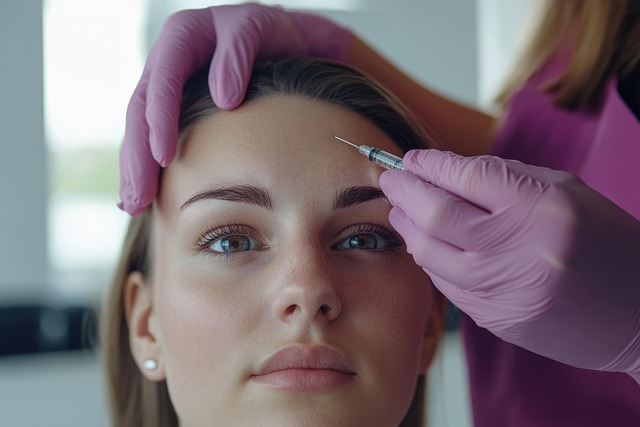Botox and dermal fillers are non-surgical wrinkle treatments targeting dynamic and static wrinkles respectively. Botox relaxes muscles for 3-6 months, while dermal fillers enhance volume up to 2 years. Choice depends on individual needs, budget, and desired results, emphasizing consultation with a qualified specialist for the best non-surgical wrinkle treatment.
“Unsure about which non-surgical wrinkle treatment is right for you? Botox and dermal fillers are popular choices for achieving a youthful complexion, but they work differently. This comprehensive guide breaks down the basics of each treatment, their unique mechanisms for wrinkle reduction, advantages, disadvantages, and key factors to consider when choosing between them. Discover which option might be best suited to your needs.”
Understanding Botox and Dermal Fillers: The Basics
Botox and dermal fillers are both popular non-surgical wrinkle treatments, but they work differently. Botox, a neurotoxin, relaxes facial muscles that cause wrinkles, while dermal fillers boost volume by injecting hyaluronic acid or other substances into the skin. Ideal for addressing dynamic lines like frown lines and crow’s feet, Botox prevents muscle contractions that lead to deep creases. Dermal fillers, on the other hand, are suitable for static wrinkles, enhancing facial contours and adding back lost volume due to aging.
Both treatments offer significant improvements in appearance with minimal recovery time. However, their effectiveness and duration vary; Botox typically lasts 3-6 months, whereas dermal fillers can last anywhere from 6 months to 2 years. The choice between the two depends on a patient’s specific concerns, budget, and desired results, highlighting the importance of consulting with a qualified dermatologist or aesthetic specialist.
How They Work for Wrinkle Reduction Differently
Botox and dermal fillers are both popular non-surgical wrinkle treatments, but they work differently to reduce fine lines and wrinkles. Botox, a type of protein produced by bacteria, relaxes muscles by blocking nerve signals. This prevents the contraction that causes dynamic wrinkles, especially around the eyes and forehead. The effects typically last for 3-6 months, after which the treatment can be repeated.
Dermal fillers, on the other hand, are made from hyaluronic acid or collagen and add volume to the skin. They fill in deep wrinkles and creases by plugging spaces between skin cells, promoting collagen production, and improving skin elasticity. Fillers provide immediate results that can last for 6 months to 2 years, depending on the specific product used. This makes them a longer-term solution compared to Botox.
Advantages and Disadvantages of Each Treatment
Advantages and Disadvantages of Each Treatment
Botox, a neurotoxin derived from bacteria, has long been the go-to non-surgical wrinkle treatment for those seeking to smooth fine lines and wrinkles. Its primary advantage lies in its ability to paralyze muscles, preventing contraction and thus reducing dynamic wrinkles around the eyes, forehead, and mouth. This makes it ideal for treating expression lines and crow’s feet. Moreover, Botox offers relatively quick results, with effects typically visible within 24-72 hours, and they can last for several months with repeated treatments. However, potential drawbacks include temporary muscle weakness or paralysis, especially around the eyes, and the need for regular injections to maintain results.
On the other hand, dermal fillers, made from hyaluronic acid or collagen, offer a different approach to wrinkle reduction by adding volume and plumping skin. The main benefit is immediate results, as these treatments enhance the skin’s natural moisture content, providing a smoother, more youthful appearance. Dermal fillers can last anywhere from 6 months to 2 years, depending on the product used, making them a longer-term solution. Yet, they may not be suitable for everyone, as there’s a risk of unintended side effects like asymmetry or an uneven skin surface. Additionally, some individuals might experience temporary redness, swelling, or bruising at the injection sites.
Choosing Between Botox and Dermal Fillers: Key Factors
When considering a non-surgical wrinkle treatment, Botox and dermal fillers are two popular options that offer distinct benefits. The choice between them largely depends on individual preferences and specific concerns.
Botox is a neurotoxin that relaxes muscles, preventing contraction and thus reducing dynamic wrinkles, especially around the eyes and forehead. It’s ideal for those seeking to soften fine lines and furrows caused by muscle movement. Dermal fillers, on the other hand, are injectable substances that add volume and lift to the skin, addressing static wrinkles and providing a more immediate result. They’re suitable for individuals wanting deeper wrinkle reduction or facial contouring. Factors like desired outcome (muscle relaxation vs. volume enhancement), treatment duration, downtime, and cost should guide your decision, ensuring you choose the most effective and suitable non-surgical wrinkle treatment.
When choosing between Botox and dermal fillers for non-surgical wrinkle treatments, it’s crucial to consider your specific concerns and desired outcomes. Both have proven effective in reducing dynamic wrinkles, but they work differently and come with unique advantages and disadvantages. By understanding these factors, you can make an informed decision that aligns best with your aesthetic goals. Remember, consulting a qualified professional will ensure the most suitable choice for your individual needs.
